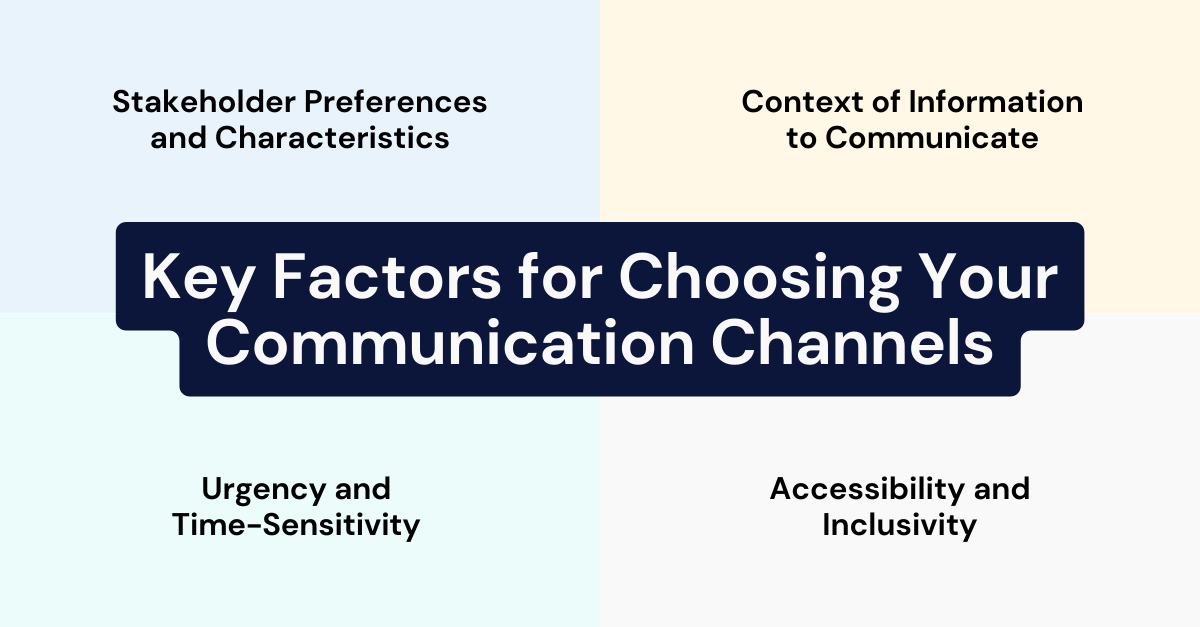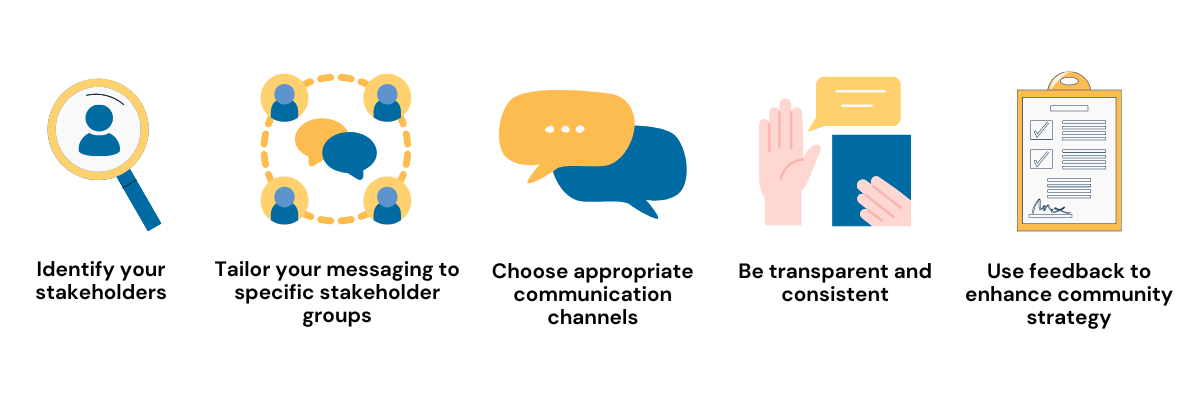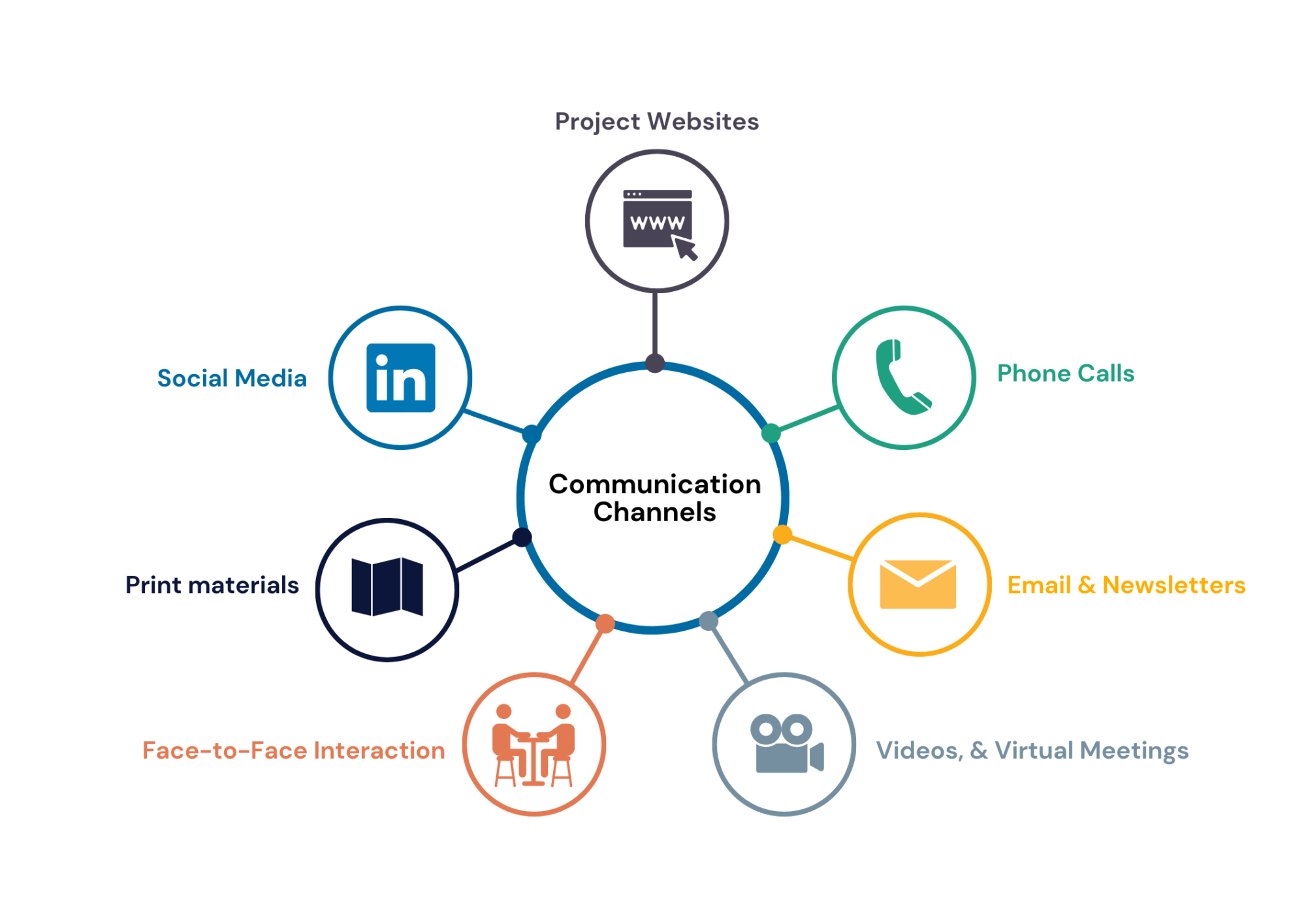Stakeholder engagement holds a pivotal role in achieving project success. Meaningful and transparent engagement fosters trust, aligns objectives, and enhances decision-making. However, grasping what communication channels you should be using is vital for effective stakeholder communication.
Communication channels serve to inform stakeholders of crucial updates and vital information. Yet, the choice of channel hinges on stakeholder preferences, accessibility, and needs. So it’s vital to choose an appropriate mix of communication channels to engage every stakeholder group with a potential impact on the project.
Within this article, we explore the significance of communication channels in stakeholder engagement, providing insights to aid your selection of well-suited channels tailored to your stakeholders’ specific requirements.

Key Factors for Choosing Your Communication Channels
When figuring out the best communication channels to connect with your stakeholders, it’s essential to take into account certain factors that could greatly impact your stakeholder engagement efforts.
- Stakeholder Preferences and Characteristics
- Context of Information to Communicate
- Urgency and Time-Sensitivity
- Accessibility and Inclusivity
Stakeholder Preferences and Characteristics
Familiarise yourself with your stakeholders’ preferences, behaviours, and attributes. Preferences may vary, with some favouring in-person interactions and others leaning towards digital communication.
Aspects like age, profession, and cultural background can further shape their preferred communication methods.
Context of Information to Communicate
Depending on the matter, consider the type of information you need to convey to your stakeholders. Is the matter sensitive or complex? Or is it only regarding regular updates and announcements?
The context of your information can greatly dictate the most appropriate channel to use.
Urgency and Time-Sensitivity
How urgently must your message be delivered? Is your message time-sensitive? Or is this more routine and considered low urgency?
Some communication channels can take time to plan, set up, and launch. When an urgent message is required, you need to make sure you have the tools to deliver.
Accessibility and Inclusivity
Ensure that your chosen communication channels are accessible to all stakeholders. Consider any language barriers, physical limitations, or technical constraints that some stakeholders may face. Provide alternative channels or accommodations to foster inclusivity.

How to communicate with stakeholders
So, you’re wanting to inform your stakeholders of important updates and information regarding your project, but you’re uncertain about how to approach your stakeholders or what channels you should use. Here are our five key tips on how to communicate with your stakeholders effectively:
- Identify your stakeholders
- Tailor your messaging to specific stakeholder groups
- Choose appropriate communication channels
- Be transparent and consistent
- Use feedback to enhance community strategy
1. Identify your stakeholders
Begin by looking at your current stakeholder data. Which stakeholders have you communicated with recently that might be impacted by your project? What stakeholders might have influence or a high level of engagement with your project?
By conducting a stakeholder analysis, and categorising them into stakeholder groups, you can have a better understanding of who your key stakeholders are and who you may need to communicate with. This means that through each stage of your project’s lifecycle, you can tailor your messages accordingly.
For a more streamlined approach, you could contemplate implementing a stakeholder relationship management platform (SRM). An SRM offers tools and insights such as capturing historical data in one centralised location to facilitate the management of stakeholder interactions. This will ensure no pivotal connection or communication opportunity is overlooked.
2. Tailor your messaging to specific stakeholder groups
Once you have defined your key stakeholders, it’s important to understand what messaging you’re going to tailor toward each group. You see, not each group will require the same level of information. So, it’s important to dive deeper and understand their distinct needs, concerns, and objectives.
For instance, imagine a renewable energy initiative installing wind turbines in a rural area. Here, stakeholders may include local residents, environmental agencies, and potential investors, with each group having distinct concerns.
You then might tailor your messaging to each stakeholder group with the following:
Local Residents
Direct your focus towards decreased energy expenses and prospects for community growth. By recognising their desire for financial savings and enhanced local infrastructure, your communication can underscore how the project will result in more economical electricity bills and generate employment within the community.
Environmental Agencies
Agencies are generally more interested in the project’s ecological and environmental benefits. Your messaging could highlight how wind turbines contribute to clean energy production, reducing carbon emissions and supporting sustainable practices.
Potential Investors
You could highlight the long-term profitability of investing in renewable energy and how it will align with their objective of maximising their investment.
As you can see, each stakeholder group has different concerns. So, tailoring your communication strategy can enhance engagement by directly acknowledging these concerns while highlighting the project’s benefits within each stakeholder category.

3. Choose appropriate communication channels
The way you communicate with your stakeholders, can depend on the nature of your project. For instance, is your message time-sensitive? Does it require detailed context? Are your stakeholders spread across various locations? By utilising an SRM, you can view previous conversations with key stakeholders, to understand what communication channel works best and is most efficient.
Below is a list of the most commonly used communication methods. Use these to engage with your stakeholders, by adjusting your approach to match their preferences and needs more effectively.
Face-to-Face Meetings, Workshops, and Conferences
These options are for direct interaction, aiding relationship-building and addressing complex issues. They provide a personal touch and create opportunities for stakeholders to ask questions and receive feedback in real-time.
Phone Calls
Immediate and direct, phone calls bridge distances for real-time conversations. They convey tone and are most suitable for urgent or sensitive matters.
Email and Newsletters
Regular updates through emails and newsletters help inform stakeholders of the progress, milestones, and events of your project. This method can also be used to communicate with stakeholders by using visual aids. Email can also be scheduled based on urgency.
Project Websites
A centralised location for accurate and up-to-date project information, which stakeholders can easily access for insights into objectives, progress, and milestones. Project websites provide a consistent space where stakeholders can visit throughout your entire project.
Social Media
Relaxed and informal, social media encourages open interactions, fostering honest exchanges and inclusivity among a diverse audience. As social media can be less formal, it can also be utilised to share timely project updates in a public setting.
Print Material
During in-person events, printed materials such as brochures provide physical resources for stakeholders who favour tangible information or have limited digital access, like certain rural areas. This ensures continued accessibility beyond the event.
Videos, Virtual Meetings, and Webinars
Virtual platforms bridge gaps, allowing face-to-face interactions and inclusivity for diverse stakeholders. Webinars and videos offer real-time engagement, interactive presentations, and recorded content for flexible access and understanding.
4. Be transparent and consistent
By fostering transparent and consistent communication, you can build trust amongst your stakeholders by helping to reduce any confusion or uncertainty.
Consider a scenario where you’re part of a residential construction project. After acknowledging the value of fostering a connection with the local community, you might opt to maintain regular updates with your stakeholders. With a thoughtful selection of communication channels, your team can consistently engage the community via town hall meetings, newsletters, or social media updates.
By openly discussing the project’s schedule, potential issues or concerns, and steps taken to minimise disruptions, the organisation reduces uncertainties for residents, all while ensuring the community stays well-informed.
5. Use feedback to enhance your communication strategy
Promote increased stakeholder engagement and communication by consistently seeking public input via surveys, feedback forms, and direct conversations.
Digital community engagement platforms like Social Pinpoint offer greater opportunities for enhanced interaction and more meaningful insights and data. This not only emphasises the significance of their feedback, but allows you to identify any shifts in sentiment or preference.
By collecting this feedback, you can use it to enhance your stakeholder communication strategy. What’s effective? What areas need to improve? Do you need to change up your communication channels?
This might involve adjusting the frequency, content, or platforms you use to match your stakeholder preferences and changing circumstances. This ongoing feedback cycle nurtures an informed, engaged stakeholder community, helping you learn and adapt your communication.
Selecting the right communication channels for stakeholder engagement is a critical aspect of project success. Remember that different channels may be required at various stages of the project or for different stakeholder groups. By considering stakeholder preferences, the nature of information, urgency, and inclusivity, you can tailor your communication strategy to effectively engage with your stakeholders.

